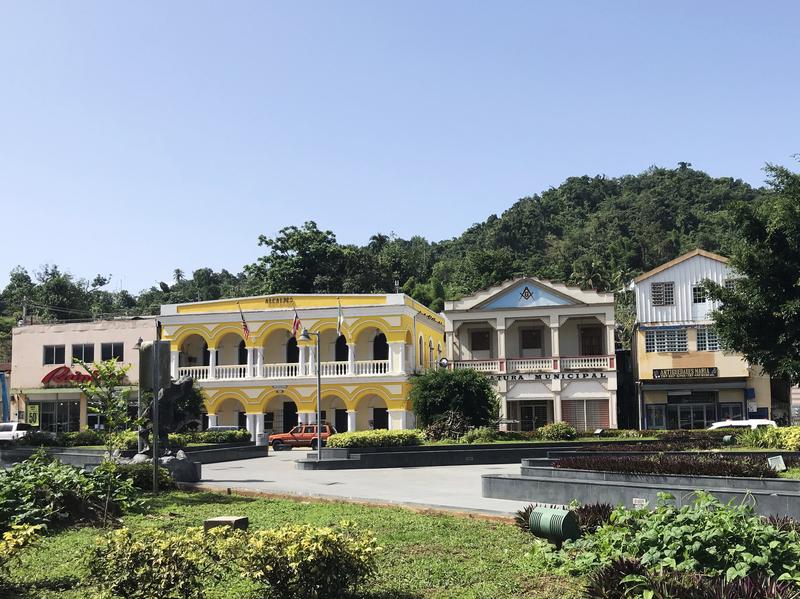Puerto Rico Harnesses The Power Of The Sun For A Renewable Energy Future

Mameyes is a small community of about 1,000 people high in Puerto Rico's central mountains. But in its own way, it is one of the leaders of Puerto Rico's energy future.
Francisco Valentin grew up in Mameyes, where he runs a small store. Even before Maria he had big ambitions for his town. After Maria, he knew he wanted his community to run on solar power. And with the help of foundations, charities and the University of Puerto Rico — not the government — he has done that, converting the town's school, health clinic and several other buildings.
The move to solar was important, Valentine says, because after Maria it took months before power was restored to the area. This makes Mameyes self-sufficient and able to respond to residents' needs in future disasters. "The whole school is fully solar energy" and can serve as a shelter, he says.
With so much sunlight on tap, solar power has begun to boom in Puerto Rico since the hurricane. Across the island, individuals, communities and businesses are installing solar panels and battery systems. At the Community Foundation of Puerto Rico, Javier Rivera is working on solar systems with 50 mostly rural, underserved communities. His goal is to wire 250 communities for solar over the next few years.
Rivera says that especially after the hurricane, people realized they couldn't depend on Puerto Rico's Electric Power Authority. "Many people [didn't] trust in the PREPA system before the hurricane. It's not a secret," he says. "People start to think about trying to find a solution, a long-term solution. And the sun is one of them."
PREPA, a government-owned utility, had severe problems long before Hurricane Maria. After decades of mismanagement, a several-billion-dollar debt drove the authority into bankruptcy. It is negotiating a repayment plan with its creditors. At the same time, the government is looking for a buyer — a private company that will take over and modernize the island's rickety transmission grid.
Fernando Padilla, one of PREPA's top executives, says he agrees that the way the company used to operate no longer makes sense. "PREPA no longer serves the needs of the people and the island," he says. "We can't continue with a monopoly if we want to transform the energy sector."
PREPA officials say they are ready to make big changes. The authority has prepared a detailed plan to rebuild its power grid into a more resilient system. It includes hardening transmission towers and lines, burying some underground. It also envisions splitting the system into eight minigrids, each with its own power generation. That is intended to prevent another extended islandwide power failure.
The first phase will cost $1.4 billion. Padilla says, optimistically, the entire rebuild will take about five years. As part of it, he says, PREPA will greatly boost the amount of power generated by renewable energy. "This is a key part of what an energy sector should look like," Padilla says.
Just a small portion of the utility's energy currently comes from renewable energy sources. Some of that renewable energy will come from communities and business with solar panels. PREPA also envisions building large solar farms.
And that's in line with a new law in Puerto Rico that sets an ambitious timetable for the shift to renewables, including solar. It calls for the island to receive half of its power from renewable sources by 2035. And to be using 100 percent renewable energy by 2050.
Padilla says the government-owned utility is committed to meeting those deadlines. But others are skeptical of the way PREPA plans to do it. "There's a gap there between what the government is saying it wants to do and what it's actually presenting to the regulators," says Sergio Marxuach, with the Center for the New Economy, a research group in San Juan.
While PREPA talks about building solar farms and other renewable sources eventually, in the short term it is investing heavily in natural gas. It has plans to build new natural gas power plants and terminals to receive shipments of liquid natural gas. PREPA says the investment in new natural gas plants and terminals is necessary as the utility begins the transition to renewable sources.
Marxuach says PREPA is doing it backward and that the company should "do as much in renewables as you can right now. Have batteries for backup. And then have as a third line of defense, if you will, the new natural gas. We think that's what makes sense for Puerto Rico."
Officials at PREPA may be listening. The latest plan for rebuilding the grid submitted last month to regulators significantly increases the amount it expects to invest in solar energy and the batteries needed to store it.
But while PREPA is studying how to shift from fossil fuels to renewables, others in Puerto Rico aren't waiting. A new study estimates that over the next five years, businesses, individuals and communities in Puerto Rico will spend more than $400 million to convert to solar energy.
9(MDEwODYxNTQyMDEzNjAxODk2Nzc2NzNmYQ001))